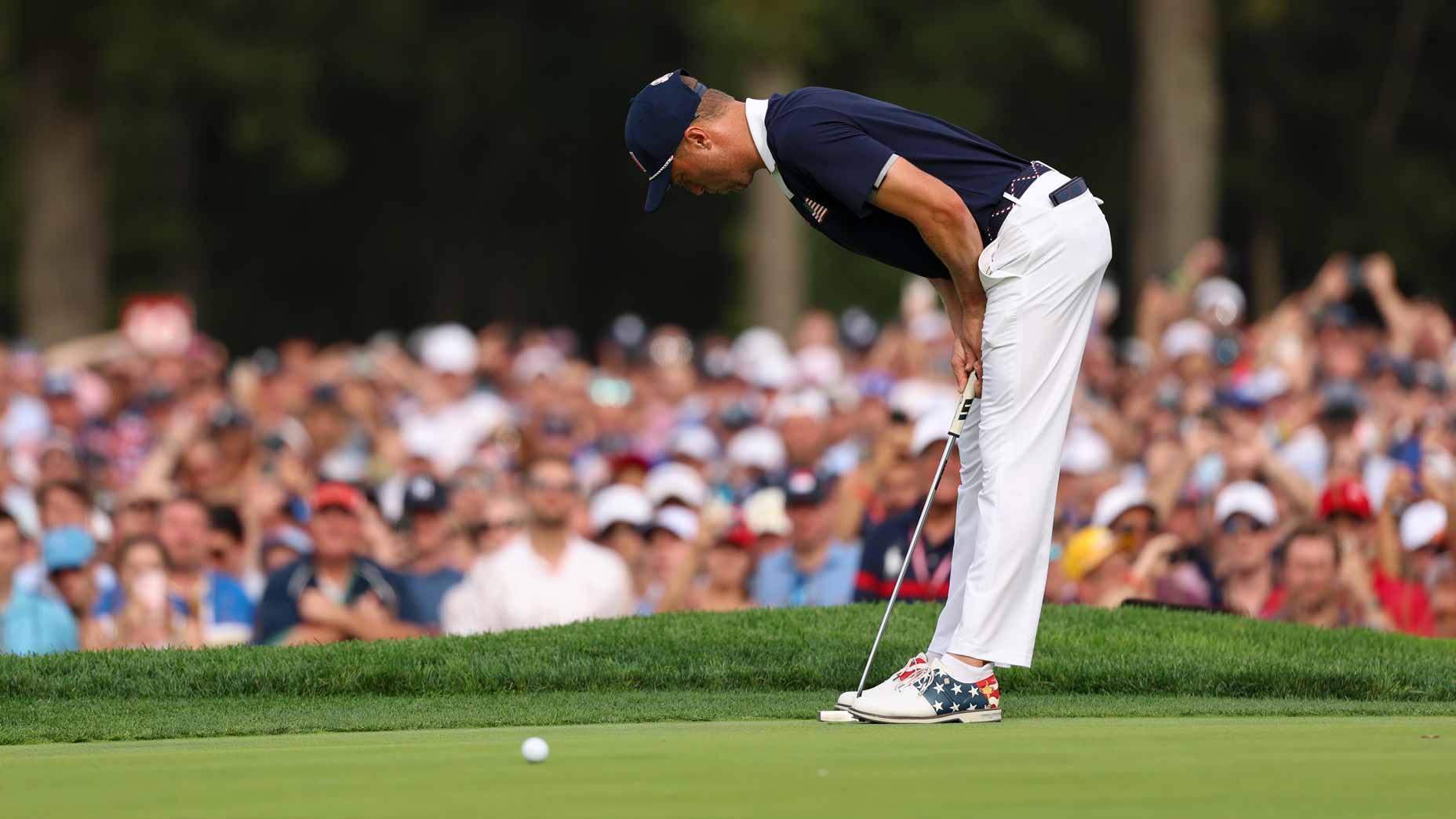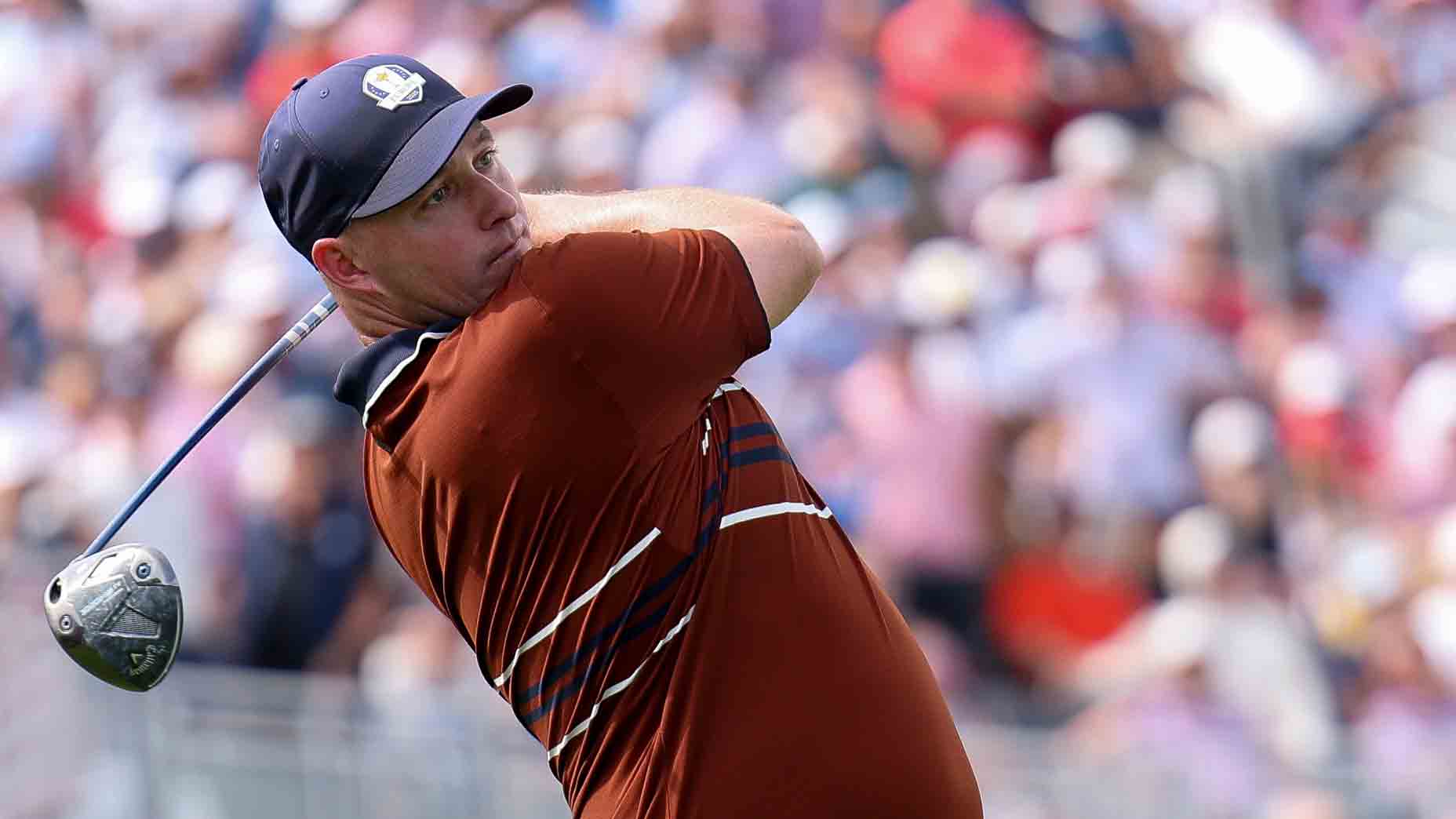Yes, Justin Thomas had a scoreboard ahead of him.
But no, he would not get relief.
But still, he tried for it. For some three minutes. Along the way, the argument featured not only the rules, but perhaps a peek at what is at stake.
The latter is a good place to start. This week, the PGA Tour is playing its final event of its regular season, the Wyndham Championship, and strokes matter just a little more — to make it to the first leg of the playoffs next week, a player must be among the top 70 of the Tour’s points standings, and Thomas entered the week at 79. And on Saturday, during the third round, he was under a tree on the right after his tee shot on the 413-yard, par-4 9th.
And an official was called.
Could Thomas punch-out to the left? Potentially. Could he hit out to the right and hook it back toward the green? Potentially — but the scoreboard was nearby. Could Thomas get relief from that? Maybe, he thought, under the rules for temporary immovable obstructions.
For clarity, below is most of the conversation he had with referee Pete Lis that was picked up by Golf Channel mics:
Said Thomas: “Obviously I have a tree in my way. Distance-wise, yeah. I mean, I understand. It just feels more like a — I just know the ruling. That’s what …”
Said Lis: “So you have to be able to get — have the ball finish on a line directly between you and the hole and the scoreboard. You have to be able to get it to that scoreboard.”
Thomas’ caddie, Jim “Bones” Mackay, stepped in. Lis continued.
Said Lis: “What’s your play, though. What direction are you going?”
With 2 fellow major winners in trouble, pro extends a (funny) rules gestureBy: Nick Piastowski
Said Thomas: “I mean, I’d be probably …”
They squatted down to look under the tree.
Said Thomas: “So what is it — if it’s between you and the — so if it’s between you, you get relief from it.”
Said Lis: “Right, but you have to be able to get the ball to finish on a direct line between right here and the hole.”
Key here was the tree. And the “direct line.” Could Thomas show that his ball would finish directly at the hole? It’s complicated, but the USGA, in a pamphlet that addresses relief from temporary immovable obstructions, says this: “There is no relief when the player cannot show that there is a stroke that he or she could reasonably play that would both (a) have the TIO (including the corridor) on the line of that stroke, and (b) result in the ball finishing on a direct line to the hole.” [On page 5 of the pamphlet is a graphic that also shows this.]
Thomas and Lis’ debate continued.
Nearly each time the referee talked, he noted some form of “direct line.”
Said Lis: “If you can get the ball to finish on a direct line between — like if you get the ball in line with the hole, then yes, you would be entitled to relief.”
With his PGA Tour season at serious risk, major winner calls format ‘silly’By: Nick Piastowski
Said Thomas: “I’m kind of where I need to go around a tree and because I need to turn it, that scoreboard or something is in the way, and I don’t get relief from that.”
Said Lis: “Well, that scoreboard also has to be on a direct line between you and the hole, which it does. That is — we’re not debating that.”
Said Thomas: “So you see the difference, though, to where it’s like, OK — I totally understand that this scoreboard … But that’s kind of the same — so it would be like if I was right here and I was trying to slice it around on the green, the scoreboard isn’t in my way, but I’m getting it to it; does that make sense? I’m trying to figure out the difference there.”
Said Lis: “It doesn’t look to me like you can get the ball to finish — with this tree here — to get the ball to finish on a direct line between you and the hole right now.”
This was the big point. The conversation continued.
Said Thomas: “I’m trying to figure what the difference in the ruling is because I’ve had it before where I’m trying to turn it and it’s not between me and the hole, but it’s in the way of my shot and I don’t get relief. But now this would be a situation where if you were going over here, it’s between me and the hole and you still don’t get relief.”
Said Lis: “No, because it’s not really on your line of play.”
Said Thomas: “But it would be on my line of play if I was — you understand what I’m saying?”
How an emotional press conference helped Billy Horschel healBy: Sean Zak
Said Lis: “But right now, where that ball lies, is not on your line of play.”
Said Thomas: “Yeah, I feel like you’re not understanding what I’m saying.”
Said Lis: “I do, but it’s not in your line of play right now. The scoreboard, based on where you have to play and getting the ball to finish on a direct line to the hole, it’s not in your line of play.”
Said Thomas: “OK, I’m just trying to figure out because I’ve had it in my line of play before where it’s not between me and the hole and I don’t get relief because it’s not between me and the hole. It’s not in my line of play. So in this situation …”
Said Lis: “You have to be able to satisfy both. You have to be able …”
Said Thomas: “It sounds like you can’t either. And that’s just what I’m saying. I’ve had it multiple times where I’m trying to turn it and I’m like — this grandstand is in my way and I don’t get relief.”
Said Lis: “… But in this one, you wouldn’t be because you can’t get the ball to finish in a line between you and the hole.”
At this point, the argument ended. Thomas punched out to the left, he bogeyed the hole, and he finished with a four-under 66.
2023 Wyndham Championship: How to watch, TV schedule, streaming, tee timesBy: Kevin Cunningham
Notably, two prominent people agreed with the ruling.
On Golf Channel, rules analyst Mark Dusbabek did. Here was his explanation: “TIOs are temporary immovable obstructions and very confusing for players and for the public and us at times. So there are two things that have to happen here. You have to have the temporary immovable obstruction between you and the hole, and number two, you have to have it on your line of play. The way Justin is playing his shot is not going to fulfill the second one. And that’s what Pete Lis was trying to explain to him.”
And the second person who was good with the call?
Thomas.
“I fully — it’s one of those, like you get rulings sometimes where you almost feel bad that it’s happening, and I truly felt like that was going to be one of those scenarios. It’s just weird. It was between me and the hole and I just had situations before where stuff like that’s happened. It’s not necessarily in your way, but because it’s between you, you get relief. It was just because the tree was there. It was one of those things like you kind of have your tail tucked between your legs asking for relief because it would only happen in a situation like this.
“But at the same time, I’m always going to ask because you never know, I could have gotten a drop and would have been able to hit on the green. So worth a shot.”














